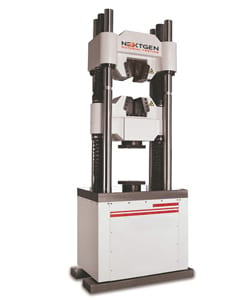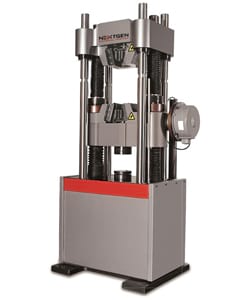
Out of all the known methods to directly gauge the strength of materials to be used for a number of applications, tensile testing is perhaps the most direct and easiest to apply.
The Universal Tensile Tester is the machine solely designed for this purpose. However, there is more to tensile testing than just pulling things apart to the point of breaking. Through the use of other variants of the testing method, one can properly determine the tensile strength of materials regardless of their size, shape, and other distinct dimensions.
What Is The Tensile Strength Test?
The concept of the tensile strength is actually quite a simple one. In order to identify the actual tensile strength level of a material, certain tension must be applied to it at various points.
The most basic way to do this is to simply pull the material at two opposite points. By calibrating the amount of tensile force required to elongate a material to its breaking point, manufacturers and engineers can predict how it will behave if a similar force is applied to it in whatever purpose it was designed for.
The advantage with the tensile strength test is the minimal preparation required to make materials compatible to the procedure. All that is required is for the tensile test samples to be cut in order to fit into the machine.
There is no need for extensive test material preparation such as removing blemishes or checking the abrasiveness of the sample’s surface. The test itself is designed to make the material undergo intense amounts of pressure and tension. This, in turn, will determine if the material fits whatever purpose manufacturers have for it.
How To Conduct the Tensile Strength Test
As was previously stated, there are several ways to determine the tensile strength of a material. However, they all follow the same purpose: to bring the material to its breaking point and determine its structural strength.
1. The Pull Test
This is the standard tensile test as mentioned above. To perform this test, the operator will place a material between two clamps. Once a specific force is set in the machine’s control panel, the clamps will move further away from each other.
This will cause the material to warp and elongate, which allows the operator to determine 3 aspects:
A. Tensile Strength – The material’s structural integrity even after it has been elongated.
B. Elongation – The length of the material after being pulled apart. In order for the elongation to be valid, the material must not break away into two parts during the stretching process.
C. Tensile Modulus – The stiffness of the material as it is being stretched. Some materials tend to become softer and fragile as they are stretched while others maintain some form of durability.
2. The Compression Test
This is the complete opposite of the standard tensile strength test. Instead of pulling the material at two points, the tensile strength tester will instead “press” on it.
Using two level plates, the operator will introduce force to the object by making the plates come closer to each other. This test typically determines three elements, which are as follows:
A. Compressive Force – The amount of force that the material sustains before breaking.
B. Load at Displacement – The distance to be covered by the two plates during the test, along with the amount of pressure applied.
C. Displacement at Load – The distance covered by the plate before the material starts “resisting” the force being applied to it.
3. The Peel Test
This is similar to the standard tensile test but is designed specifically for materials that have been bonded together using binding agents or through welding procedures. To do this test, the clamps of a tensile tester machine will hold the separate ends of both bonded materials.
Once the materials are secured to the machine, it will then slowly pull them apart. The pressure being applied to the test will be measured 1000 times per second and will be designated as the average peel force.
This test does not determine the tensile strength of the bonded materials per se. Instead, it will gauge the strength of the binding agent or process used to combine these separate materials together.
4. The Bend Test
This is a variant of the compression test and thus, will operate on the same parameters. However, it is designed specifically for materials of considerable length like metal/wooden beams and support struts.
The material will be placed across two blocks at the tensile test apparatus with a compressor plate at the top. The test is then conducted by lowering the plate into the middle of the material until it breaks or the plate reaches a certain distance.
Slightly similar to the standard tensile test, the bend test identifies two factors:
A. Flexural Strength – How strong the material remains after it has flexed, especially at the point of flexure.
B. Flexural Modulus – The integrity of the material after it has been bended.
5. The Puncture Test
Like the Rockwell and Vickers hardness tests (designed for high-density metals and plastics), the Puncture Test involves the application of pressure to the material through a probe from above. In this test, the operator will prepare the material to fit the circular dimensions that the test requires.
Once secured into the machine, the probe will then be lowered into the test sample. The procedure is designed to identify a material’s puncture resistance and, thus is ideal for metal sheets and liquid product containers.

Benefits
As it was designed to provide data on the structural integrity of a material, the results from a Tensile Test can be used in a number of applications that include:
A. Determining Batch Quality – The quality of the component materials often determines the sample’s structural integrity. As a matter of fact, a single substandard base material will be enough to render an entire component unfit for usage. As such, testers can be used to determine if an entire production batch is consistent with generally accepted manufacturing standards.
B. Improving Design and Manufacturing Procedures – There is no telling how good a product is before it is used by consumers. With tensile test machines, however, one can predict how these products will react if exposed to similar elements found in the test.
This will serve as an opportunity for manufacturers to improve on their design by exposing critical flaws in the samples. This could also lead to them optimizing on their manufacturing costs by replacing substandard materials with more durable alternatives.
C. Failure Analysis – From a certain point of view, these tests do not only tell if a material is compatible with the purpose it will be used for. It could also help manufacturers identify how and why such materials would fail.
By making a material reach its breaking point, testers can determine at what point and in what manner will their products undergo critical failure. This could be used to improve on their products or educate end-users on the correct usage to prevent unwanted incidents.
An Important Note
Regardless of the name, it is crucial to remember that not every universal tensile strength test machine is designed to perform all 5 tests. At best, one should find a machine that comes with multiple grips designed to conduct every known tensile stress test effectively.
A Universal Test Machine capable should be able to determine how structurally strong any test sample before the material is applied for whatever purpose its manufacturers have in mind for it.
To learn more about these test methods or to inquire about a customer solution for your facility, contact us today.